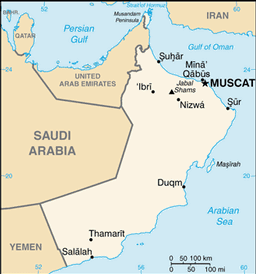Oman

About the Flag
Oman is a monarchy and a member of the Arab League, the UN, and IMO. It is located in the Middle East bordering the Arabian Sea, Gulf of Oman and the Persian Gulf between Yemen and the United Arab Emirates. Arabic is the official language with 75% of the population belonging to the Ibadhi sect of Islam. The capital is Muscat, and the legal system is based on English common law and Islamic law with ultimate appeal to the Sultan (the chief of state and head of government). There is a unicameral Consultative Council.
Oman is a middle-income economy that is heavily dependent on dwindling oil resources. Because of declining reserves and a rapidly growing labor force, Muscat has actively pursued a development plan that focuses on diversification, industrialization, and privatization, with the objective of reducing the oil sector's contribution to GDP to 9% by 2020 and creating more jobs to employ the rising numbers of Omanis entering the workforce. Tourism and gas-based industries are key components of the government's diversification strategy. By using enhanced oil recovery techniques, Oman succeeded in increasing oil production, giving the country more time to diversify, and the increase in global oil prices throughout 2010 provides the government greater financial resources to invest in non-oil sectors. Oil production is the economic mainstay but fish, processed copper, and textiles are also important industries. Major trading partners include the United Arab Emirates, Japan, and South Korea. The unit of currency is the Omani rial.
Merchant shipping is regulated by Sultani Decree No. 35/81 (1981), and the Law Regulating Navigation in Territorial Waters Sultani Decree 98/81 (1981) administered by the Ministry of Communication.

